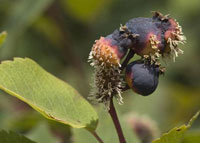Gymnosporangium species (spp.)
Hosts
Hawthorn, Saskatoon, other rose family hosts
Distribution and Disease Cycle

Photo credit: Iowa State University Plant and Insect Diagnostic Clinic
Gymnosporangium Rust, also called Quince Rust, is caused by a few species of fungus which infect hawthorn, Saskatoon and other members of the Rose family throughout North America. Rust infections occur more frequently on the fruit, but can also be found on twigs, buds or sometimes leaves. The rust fungus requires two hosts to complete its disease cycle; a Rose family host and a Juniper host.
Spores are produced on infected junipers in spring, spreading by wind to susceptible hawthorn and Saskatoon plants nearby. Beginning a few weeks after initial infection, the fungus produces a spore stage resulting in conspicuous long white tubes covering the fruit, that eventually rupture releasing reddish spores which spread by wind to infect nearby junipers. Cankered areas on juniper hosts can continue to produce spores for several years as the fungus expands.
Symptoms and Signs

Photo credit: Bob Ross, Oregon State University Extension
Infected leaves often have small flecks or lesions of necrotic tissue. Infected fruit may either fall prematurely or remain on the tree, but be misshapen with sunken lesions and necrotic tissue deep in the fruit. A spore stage on fruit produces distinguishable long white tubes that eventually release reddish coloured spores. Infections on the alternate host (junipers) produce swollen, spindle-shaped cankers on stems, which exude a red/orange gelatinous (spore producing) mass during rain periods in spring.
Control
If possible, avoid planting hawthorns and Saskatoons near common juniper (Juniperus communis), creeping juniper (Juniperus horizontalis) and Rocky Mountain juniper (Juniperus scopulorum), which are alternate hosts for these rusts. Fungicides containing cholorothalonil applied before bloom or myclobutanil applied every 14 days after disease appearance provide some control. Apply all chemicals as per label instructions.